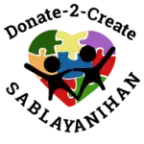we help indigent children and communities in sablayan municipality
Municipality of Sablayan
Donate-2-Create : Sablayanihan seeks to help underprivileged children of Sablayan by providing them free basic necessities which could help them succeed in life. Beneficiaries of our program are the children of fisher folk, farmer, indigenous peoples – the Mangyans and other low-income families whose income are insufficient to support the children´s basic needs.
Together with generous donors, local officials and communities we work to promote the well-being of these children and help fulfill their full potential.
Sablayan is one of the municipalities of Occidental Mindoro Province. With a total land area of 2,188.80 square kilometers, it is considered as the largest municipality of the Philippines. It is subdivided to twenty-two (22) barangays. Majority of its over 90, 000 inhabitants are engaged in farming and fishing.
The municipality’s waters, forests and mountains are unique habitats of of some of most endangered and endemic plant and animal species. It is also the home of the Tao Buid and Batangan tribes of the Mangyan, the indigenous peoples of the island of Mindoro.
